Within the opening seconds of Australia Day (Kriv Stenders, 2017), we’re off and running. The film cuts between separate pairs of feet pounding the pavement, the thudding score driving us forward with them. As the faces of our three protagonists are revealed, desperation writ plainly across them, we become locked into their breathless beats for the remainder of the film, with little chance to exhale. The three paths we follow are those of April (Miah Madden), a fourteen-year-old Aboriginal Australian fleeing from domestic violence and a police chase that left her sister dead; Lan (Jenny Wu), a Chinese woman whose broken English prevents her from communicating the terror from which she is escaping, but who is adamant that the police won’t help; and Sami (Elias Anton), a second-generation Iranian-Australian accused of raping his teenage friend Chloe (Isabelle Cornish) by her revenge-seeking older brothers. This opening sequence neatly sets up the high stakes of the film, structurally and thematically; it is an ambitious, intricate work that is compositionally satisfying and vigorously directed. Yet the power exerted in its delivery does, at times, risk wearing the viewer down.
Australia Day, explained Stenders during a Q&A following the film’s premiere at the 2017 Sydney Film Festival (SFF), is intended to be a snapshot of contemporary Australia.[1]Kriv Stenders, in Australia Day post-screening Q&A, Sydney Film Festival, 12 June 2017. It presents the viewer with a compendium of social ills: violence, racism, homophobia, sexism, addiction, child abuse, suicide, sexual slavery, Aboriginal deaths as a result of police action, Islamophobia, economic bankruptcy, soldiers’ post-traumatic stress disorder, free trade deals and so forth. Each of these issues is raised at some point in the journeys of our three characters, whose stories of victimisation, escape and attempts to take control eventually interweave across the swiftly paced film. Stenders also stated that Australia Day was not seeking to provide any answers to the questions it raises about our society.[2]ibid. Even so, these ideas seem structured less as thought-provoking inquiries than a barrage of issues. There is no denying the importance of every one of these concerns, yet their rampant delivery precludes any space for digestion before we race on to the next problem. While the audience is never given a chance to be bored in the ninety-eight-minute running time, the brisk clip also leaves little space for reflection.

Precedents and production
The film’s action unfolds sequentially over the course of the Australia Day public holiday in Brisbane and its surrounding suburbs. The confines provided by this restricted timeframe prevent the film from sprawling beyond its already-sweeping focus, and allows writer Stephen M Irwin – who worked on Channel Ten’s Wake in Fright miniseries and TV series Secrets & Lies, on top of having a background in penning horror novels – to establish his credentials for exploring the underbelly of Australian society. During the same SFF Q&A, Irwin pinpointed the elements of ‘tropical noir’ that inflect Australia Day’s storyline with a pervading sense of menace, but asserted that he wanted to convey realism by grounding the characters is one specific location.[3]Stephen M Irwin, in Australia Day post-screening Q&A, ibid. This setting is established through repeated bright, soaring overhead shots of the suburbs. The buildings below appear as though children’s cubbyhouses, and these images are frequently followed by jarring juxtapositions – to the bruised and blooded Sami imprisoned in a darkened garage, for instance.
The film’s exploration of what lies beneath mundane suburbia evokes David Lynch’s Blue Velvet (1986), with comparisons similarly made between his Twin Peaks and Irwin’s dark envisioning of familial tragedy in Secrets & Lies.[4]Melissa Overman, ‘Secrets & Lies: Watch the Full Episode Here’, News.com.au, 24 February 2014, <http://www.news.com.au/entertainment/tv/secrets-lies-watch-the-full-episode-here/news-story/f84e9e6dfcc50829cfc48a4ed9a50a4e>, accessed 9 February 2018. Transposed here to overturn the Australian facade of sunny, relaxed good humour, Australia Day is similarly aligned with Lantana (Ray Lawrence, 2001), Alexandra’s Project (Rolf de Heer, 2003) and even the recent Jasper Jones (Rachel Perkins, 2017) in its use of latent violence to interrogate ‘Australian values’. In Stenders’ film, characters such as cattle farmer Terry (Bryan Brown) and police officer Sonya (Shari Sebbens), bystanders thrown bewildered into the action, enable us to contemplate how we would respond in a similar scenario – whether we would have the courage to intervene or decide that it wasn’t our place to interfere.
Australia Day has little time for such excavations, and many of the characters remain roughly hewn … While we gain an understanding of their motivations, this is based on their social status and our assumptions about the minoritised group for which they stand.
On a subtler note, the Southern Cross tattoo sported by Dean (Sean Keenan), who seeks to avenge his sister’s alleged rape by Sami, brings to mind Warwick Thornton’s explication of such symbolism in We Don’t Need a Map (2017). Further associations of patriotism and overt racism are echoed in a separate scene of flag-festooned men, who taunt April with ‘Happy Invasion Day!’ The imagery is reminiscent of black comedy Down Under (Abe Forsythe, 2016), which explores cultural tensions in the aftermath of the 2005 Cronulla Riots. In Australia Day, the men’s exit from the car to trail April down the street conveys a very real and familiar sense of threat, which testifies to the convincing tone of dread maintained throughout the film.
Stenders, too, has explored different manifestations of the Australian story over the course of his career, his invocation of national archetypes and scenarios seen in Blacktown (2005), Lucky Country (2009), and Red Dog (2011) and its sequel (2016). Rather than shattering or overturning the stereotypes completely, though, he digs deeper to subvert them and, in the process, diffuses and disperses the audience’s preconceptions about his characters. Unfortunately, Australia Day has little time for such excavations, and many of the characters remain roughly hewn, unable to move beyond representative status. While we gain an understanding of their motivations, this is based on their social status and our assumptions about the minoritised group for which they stand, rather than any particular insight into them as individuals. April is the most thoroughly developed character and has the most compelling and emotionally engaging storyline of the three, thereby highlighting what is missing from the other plot strands. This is despite some strong performances from the two other young leads, and from Brown and Sebbens in supporting roles.

In terms of production values, Australia Day is a step up in scale from Stenders’ previous films. At SFF, the director described how the 150 acting parts and twenty-day shoot created a tight turnaround that galvanised the cast and crew; with very little coverage shot, the pressure was on the performers to nail each single take. Having previously worked this way on Boxing Day (2007), which was shot in just five days, Stenders knew this was possible.[5]Stenders, op. cit.
Behind the production of Australia Day was Hoodlum Entertainment, in partnership with Foxtel. This is the first feature film to result from Foxtel’s initiative to double its investment in Australian programming, an announcement made when Netflix reached Australian shores in 2015.[6]Don Groves, ‘Foxtel Flags Record Investment in Local Content’, IF.com.au, 16 June 2015, <https://www.if.com.au/foxtel-flags-record-investment-in-local-content/>, accessed 9 February 2018. Foxtel’s involvement in Australia Day was hailed by Stenders as setting a precedent for films with confrontational themes to receive such funding, as they are usually sidestepped by major investors.[7]Stenders, op. cit.

Themes and techniques
Australia Day’s three scenarios are deftly edited by Nick Meyers, though the transitions between them are, at times, abrupt. We see a close-up of a phone being smashed, for instance, followed by a cut to another character picking up their phone to answer it; or a reference is made to ‘the cops’, which is matched to a shot of Sonya with the sound of a siren in the background. Nonetheless, for a film with so many twists and turns, the ease with which viewers can orient themselves within the narrative – along with the overall cohesiveness of the various plotlines – is a strong achievement. Interspersed with this crosscutting between our key protagonists are shots of the Brisbane cityscape at different times of day, creating a coherent sense of time and place that is hammered home by multiple TV sets blaring coverage of the Australia Day celebrations in the background of every room.
Throughout the film, Stenders maintains a fluid mobility to match our close pursuit of his characters. The camera trails a few steps behind and, once they pause, circles around to hover on their faces. This technique is a more polished incarnation of Boxing Day’s handheld aesthetic, which weaves around the confines of a house in long takes redolent of Alfred Hitchcock’s Rope (1948). There is a certain form of empathetic distance created by this choice of cinematography; we are in the middle of the action and running alongside our protagonists from the get-go, but are then forced to stand helplessly by and regard their anguish when things go awry. In the key moments of threat, our focus on the emotional state of the characters is underscored by isolated pieces of white noise on the soundtrack, before the surrounding diegetic sounds fade back in.

This positions viewers in a very deliberate way in relation to the action: without presuming that we can completely understand the experiences of these characters, it engenders a questioning of our own standpoint of observation and detachment. As spectators, we are made to feel a sense of complicity in the persecution of these characters, simply by virtue of our silent, passive presence. Yet this distance also contributes to the victimisation of these individuals: across much of the film we watch them flail under the weight of structural inequalities and societal pressures, as well as the brutality of the individuals who enact extreme forms of the racism and xenophobia that permeate our society. The moments when the characters are able to gain some control of their situations feel somewhat forced and, thus, ring false – the too-convenient synchronicity of the storylines may be at fault here. The results, particularly in Lan’s storyline, step beyond the register of realism that the film has hitherto sustained. Australia Day suggests – most strongly through the character of Sami, who insists ‘this has to stop’ – that individuals, particularly those of the younger generation, do have the ability to intervene and shift the power dynamic.
Australia Day acts as an entry point for a wider discussion of the problems facing our nation today. The themes of displacement and identity run throughout, with Irwin describing the central idea as, ‘Where do we all fit in and how do we make room?’[8]Irwin, op. cit. The film’s title is an indictment of what the eponymous holiday has come to mean – tied, in its current form, to a specific type of nationalism that excludes non-mainstream expressions of Australian identity – but its ending offers hope that attitudinal change can be effected. Social-issues films of this type must always find a space between the commercial exploitation of a topical subject and a preachy advocacy that can be off-putting to viewers. Indeed, Australia Day strives to find a balance in presenting both the vulnerability and the agency of its protagonists, who are victims of larger societal forces yet able, in time, to take charge of their circumstances. Stenders’ tidy packaging of these political concerns is strongly delivered, but the film also sacrifices some of its impact in its attempt to cover so much ground in such a short period of time.
Endnotes
| 1 | Kriv Stenders, in Australia Day post-screening Q&A, Sydney Film Festival, 12 June 2017. |
|---|---|
| 2 | ibid. |
| 3 | Stephen M Irwin, in Australia Day post-screening Q&A, ibid. |
| 4 | Melissa Overman, ‘Secrets & Lies: Watch the Full Episode Here’, News.com.au, 24 February 2014, <http://www.news.com.au/entertainment/tv/secrets-lies-watch-the-full-episode-here/news-story/f84e9e6dfcc50829cfc48a4ed9a50a4e>, accessed 9 February 2018. |
| 5 | Stenders, op. cit. |
| 6 | Don Groves, ‘Foxtel Flags Record Investment in Local Content’, IF.com.au, 16 June 2015, <https://www.if.com.au/foxtel-flags-record-investment-in-local-content/>, accessed 9 February 2018. |
| 7 | Stenders, op. cit. |
| 8 | Irwin, op. cit. |





